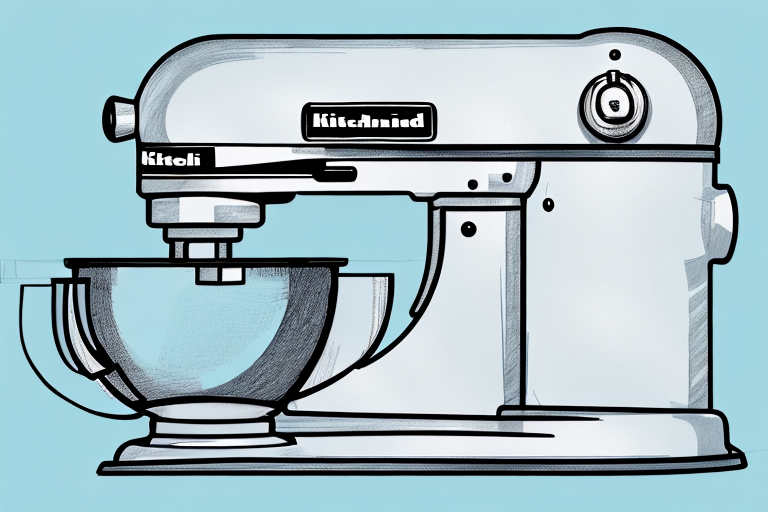How to Pack a KitchenAid Mixer for Moving: A Step-by-Step Guide

Moving can be an overwhelming experience, especially when it comes to packing delicate and bulky items such as a KitchenAid mixer. Your mixer is one of your most valuable and frequently used kitchen appliances, so it’s essential to take extra care when packing it to prevent any damage during transit.
Preparing Your KitchenAid Mixer for Packing
Cleaning and Drying Your Mixer
The very first step in packing your KitchenAid mixer for moving is to ensure that it is clean and dry. Wipe down all the mixer components, including the base, bowl, and attachments, to remove any dirt and grime that might have accumulated during use. Use a soft cloth and mild detergent to clean the mixer and its components. Make sure that you remove any food particles that might be stuck to the mixer or its components. Rinse the mixer and its components with warm water and allow them to dry thoroughly before disassembling it for packing.
If your mixer has any stubborn stains or grease, you can use a mixture of baking soda and water to remove them. Apply the paste to the stains and let it sit for a few minutes before wiping it off with a damp cloth. Rinse the mixer and its components with warm water and dry them thoroughly.
Disassembling the Mixer Components
The next step is to disassemble the KitchenAid mixer into its individual components. Remove the mixing bowl, paddle attachment, whisk, dough hook, and, if applicable, the pouring shield. Pack these items separately to prevent them from jostling around inside the mixer during transit. Use bubble wrap or packing paper to wrap each component individually to protect them from scratches and damage during transit.
Label each component with a marker or tape to make it easier to reassemble the mixer when you arrive at your destination. Make sure to keep all the components together in a single box to avoid misplacing them during transit.
Gathering Necessary Packing Materials
Before you start packing your KitchenAid mixer, make sure you have all the necessary packing materials at hand. You’ll need packing paper, bubble wrap, packing tape, packing peanuts, and a sturdy box that is large enough to fit the mixer and its components comfortably.
Make sure that you choose a box that is strong enough to hold the weight of the mixer and its components. You can use a double-walled box or reinforce a single-walled box with packing tape to make it stronger.
Use packing peanuts or crumpled packing paper to fill any empty spaces in the box and prevent the mixer and its components from shifting during transit. Seal the box with packing tape and label it with the words “Fragile” and “KitchenAid Mixer” to alert the movers to handle it with care.
By following these simple steps, you can ensure that your KitchenAid mixer arrives at your new home safely and in one piece. Happy moving!
Protecting Your KitchenAid Mixer
Moving can be a stressful time, especially when it comes to packing up your beloved kitchen appliances. Your KitchenAid mixer is likely one of your most prized possessions, and you want to make sure it arrives at your new home in one piece. Here are some tips for protecting your KitchenAid mixer during transit.
Wrapping the Mixer Base
The KitchenAid mixer base is the largest component and the most vulnerable to damage during transit. Start by wrapping the base with packing paper to protect it from scratches and dents. You can also use foam sheets to provide an extra layer of protection. Next, wrap it with several layers of bubble wrap and secure it with packing tape. Make sure the tape is tightly wrapped around the base to prevent the bubble wrap from coming loose.
Pro tip: If you still have the original box that the mixer came in, use it! The box is designed to fit the mixer perfectly and will provide the best protection during transit.
Securing the Mixing Bowl and Attachments
The mixing bowl and attachable components are fragile and can easily break during transit. Wrap the bowl and attachments separately in packing paper and bubble wrap to cushion them against any impact. Use packing tape to secure the bubble wrap in place. If you have the original box, you can also pack the bowl and attachments inside it, along with the mixer base.
Pro tip: If you have any small attachments, like the wire whisk or dough hook, place them inside the mixing bowl before wrapping it up. This will help prevent them from getting lost or damaged during transit.
Reinforcing Fragile Parts
Some KitchenAid mixer components, such as the power cord and beater shaft, are delicate and prone to damage during transit. Reinforce these parts by wrapping them with extra layers of bubble wrap and securing them with packing tape. You can also use foam sheets to provide additional protection.
Pro tip: If you’re worried about the power cord getting tangled during transit, wrap it up and secure it with a twist tie or rubber band.
By following these tips, you can ensure that your KitchenAid mixer arrives at your new home safe and sound. Happy moving!
Packing the KitchenAid Mixer in a Box
Packing your KitchenAid mixer in a box can be a daunting task, but with proper preparation and packing techniques, you can ensure that your mixer arrives at its destination safe and sound. Here are some additional tips to help you pack your KitchenAid mixer for shipping.
Choosing the Right Box Size
Choosing the right box size is crucial to ensure that your mixer is protected during transit. It is important to choose a box that is sturdy and large enough to fit the mixer and its components comfortably. A box that is too small might damage the mixer, while a box that is too big might allow the mixer to move around during transit. Consider using a double-walled box for added protection.
When selecting a box, make sure that it is clean and free from any debris or dust. This will help prevent any damage to your mixer during transit.
Layering the Bottom of the Box
Layering the bottom of the box is an important step in protecting your mixer during transit. The bottom of the box should be layered with packing peanuts, bubble wrap or crumpled packing paper to cushion the mixer and its components against any impact during transit. Spread out the packing materials evenly so that the weight of the mixer is distributed evenly.
It is important to make sure that the packing materials are tightly packed, but not too tight that they cause pressure on the mixer. This will help prevent any damage to your mixer during transit.
Placing the Mixer and Components in the Box
When placing the mixer and its components in the box, it is important to take extra care to ensure that they are protected during transit. Place the wrapped mixer base in the center of the box and surround it with the wrapped mixing bowl and attachments. Fill any empty spaces with packing materials, making sure that they are snugly packed to prevent any movement during transit.
It is important to make sure that the mixer and its components are tightly packed, but not too tight that they cause pressure on each other. This will help prevent any damage to your mixer during transit.
Sealing and Labeling the Box
Once the mixer and its components are securely packed inside the box, seal it with packing tape. Use a marker to label the box with the contents inside and indicate which side should be kept upright during transit.
It is important to make sure that the box is tightly sealed to prevent any movement during transit. This will help ensure that your mixer arrives at its destination safe and sound.
By following these tips, you can ensure that your KitchenAid mixer is packed and shipped safely, allowing you to enjoy your favorite recipes in no time!
Transporting Your KitchenAid Mixer Safely
Loading the Box into the Moving Vehicle
Avoid placing other heavy items on top of the box containing the mixer during transit. Instead, keep it on top of other boxes or lightweight items. If possible, pack the mixer in your car to prevent any damage caused by rough handling.
Keeping the Mixer Upright During Transit
It’s crucial to keep the mixer upright during transit to avoid any damages caused by tipping over. If you’re traveling a long distance, consider using a moving company specializing in fragile items to transport your mixer safely.
Unpacking and Reassembling Your Mixer at Your New Home
When you reach your destination, unpack your KitchenAid mixer with caution. Remove all the packing materials carefully and reassemble the mixer components. Test the mixer to ensure it works correctly after transit, and before you start using it again.
Conclusion
Packing a KitchenAid mixer for moving sounds complicated, but these simple steps can help you pack your kitchen’s most valuable appliance safely. Be patient and follow the guidelines carefully to avoid any damage to your mixer. With proper packing, your mixer will arrive at its new home in perfect condition, ready to serve you once again. Happy moving!



